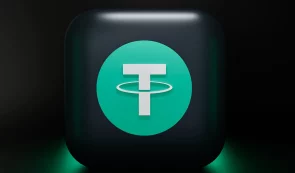What is Tether
Tether (USDT) is a stablecoin (a type of cryptocurrency) pegged to the US dollar and backed by “100% of Tether’s reserves,” according to the company’s website. The crypto community often questions these claims.
Tether is owned by iFinex, the Hong Kong-listed company that also owns the BitFinex crypto exchange.
Tether was launched as RealCoin in July 2014 and rebranded to Tether in November 2014. It began trading in February 2015 under the symbol USDT.
How does Tether work?
When a user deposits fiat currency into Tether’s reserve, selling fiat to buy USDT, Tether issues the corresponding digital token amount. USDT can then be sent, stored, or exchanged.
If a user deposits $100 into Tether’s reserve, they will receive 100 Tether tokens at 1:1 parity with the US dollar. USDT is destroyed and withdrawn from circulation when users exchange the tokens for fiat currency.
Tether is transferred through a blockchain like many other digital currencies.
Tether is integrated into several blockchains, which has helped it become widely available. Here are the blockchain networks that currently support Tether:
- Bitcoin
- Ethereum
- Tron
- EOS
- LIQUID
- Algorand
- Bitcoin Cash
- Solana
- Stablecoins
Tether belongs to the so-called “stablecoins,” which aim to keep the price of their coins fixed, most often by pegging it to the price of a traditional currency like the US dollar. (Tether also issues tokens pegged to the euro, the offshore Chinese yuan, and gold, but none are more than a fraction of the market cap of USDT tokens pegged to the US dollar.)
This peg to traditional currencies ensures that stablecoins are not influenced by the volatility of crypto markets, as is the case with more speculative digital assets such as Bitcoin.
Tether updates a daily breakdown of its reserves on its website. As of May 12, 2022, Tether reported holding 83.74% of its reserves in cash, cash equivalents, short-term deposits, and commercial paper, 4.61% in corporate bonds, 5.27% in secured loans to unrelated parties, and 6.38% in other investments, including digital tokens.
The stable value encourages the use of stablecoins as a medium of exchange, similar to conventional money.
Unregulated activity
In 2019, New York Attorney General Leticia James filed a lawsuit against iFinex alleging that the cryptocurrency exchange Bitfinex failed to secure a reliable fiat banking relationship, entrusting $1 billion to Panamanian payment processing firm Crypto Capital Corp and covering $850 million in losses missing since mid-2018.
The funds were allegedly commingled with corporate and customer deposits, and a contract was allegedly never signed with Crypto Capital. The indictment alleges that Crypto Capital Corp lost or stole the money, and Bitfinex and Tether Limited executives failed to recover the $850 million in question. iFinex, Bitfinex, and Tether Limited allegedly used Tether to cover up the shortfall.
Tether is called a stablecoin or stablecoin because it was originally designed always to be worth $1.00, maintaining a reserve of $1.00 for every USDT issued.
On April 30, 2019, Tether Limited’s attorney stated that each USDT is backed by only $0.74 in cash equivalents. Despite all the criticism directed at the asset, Tether claims to be transparent about its reserves.
With USDT, you can theoretically switch to a coin that has a stable value like the US dollar – even when you’re on an exchange that doesn’t deal in fiat currencies. Many exchanges also offer USDT as a trading pair, thus allowing you to buy other cryptocurrencies with a token that acts like the US dollar. This is very useful (especially when the price of Bitcoin is so volatile).
After long legal battles, iFinex has successfully refuted stolen funds and cover-up claims.
Bitfinex claimed it had repaid the loans in full with interest to Tether Limited by February 5, 2021, and settled the legal dispute with the New York Attorney General’s Office by paying $18.5 million.



